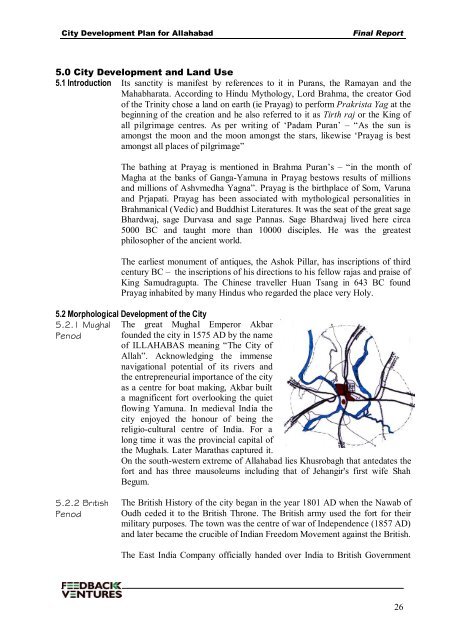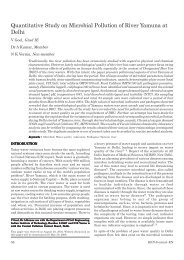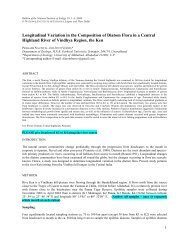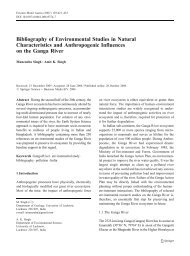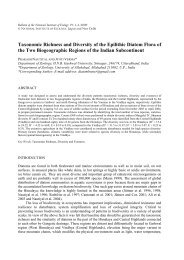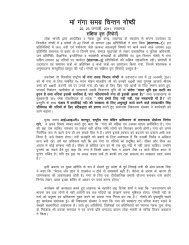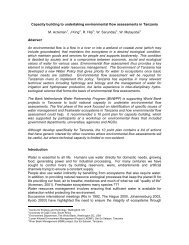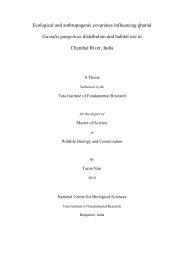Contents - GANGAPEDIA
Contents - GANGAPEDIA
Contents - GANGAPEDIA
Create successful ePaper yourself
Turn your PDF publications into a flip-book with our unique Google optimized e-Paper software.
City Development Plan for Allahabad Final Report<br />
5.0 City Development and Land Use<br />
5.1 Introduction Its sanctity is manifest by references to it in Purans, the Ramayan and the<br />
Mahabharata. According to Hindu Mythology, Lord Brahma, the creator God<br />
of the Trinity chose a land on earth (ie Prayag) to perform Prakrista Yag at the<br />
beginning of the creation and he also referred to it as Tirth raj or the King of<br />
all pilgrimage centres. As per writing of ‘Padam Puran’ – “As the sun is<br />
amongst the moon and the moon amongst the stars, likewise ‘Prayag is best<br />
amongst all places of pilgrimage”<br />
The bathing at Prayag is mentioned in Brahma Puran’s – “in the month of<br />
Magha at the banks of Ganga-Yamuna in Prayag bestows results of millions<br />
and millions of Ashvmedha Yagna”. Prayag is the birthplace of Som, Varuna<br />
and Prjapati. Prayag has been associated with mythological personalities in<br />
Brahmanical (Vedic) and Buddhist Literatures. It was the seat of the great sage<br />
Bhardwaj, sage Durvasa and sage Pannas. Sage Bhardwaj lived here circa<br />
5000 BC and taught more than 10000 disciples. He was the greatest<br />
philosopher of the ancient world.<br />
The earliest monument of antiques, the Ashok Pillar, has inscriptions of third<br />
century BC – the inscriptions of his directions to his fellow rajas and praise of<br />
King Samudragupta. The Chinese traveller Huan Tsang in 643 BC found<br />
Prayag inhabited by many Hindus who regarded the place very Holy.<br />
5.2 Morphological Development of the City<br />
5.2.1 Mughal<br />
Period<br />
5.2.2 British<br />
Period<br />
The great Mughal Emperor Akbar<br />
founded the city in 1575 AD by the name<br />
of ILLAHABAS meaning “The City of<br />
Allah”. Acknowledging the immense<br />
navigational potential of its rivers and<br />
the entrepreneurial importance of the city<br />
as a centre for boat making, Akbar built<br />
a magnificent fort overlooking the quiet<br />
flowing Yamuna. In medieval India the<br />
city enjoyed the honour of being the<br />
religio-cultural centre of India. For a<br />
long time it was the provincial capital of<br />
the Mughals. Later Marathas captured it.<br />
On the south-western extreme of Allahabad lies Khusrobagh that antedates the<br />
fort and has three mausoleums including that of Jehangir's first wife Shah<br />
Begum.<br />
The British History of the city began in the year 1801 AD when the Nawab of<br />
Oudh ceded it to the British Throne. The British army used the fort for their<br />
military purposes. The town was the centre of war of Independence (1857 AD)<br />
and later became the crucible of Indian Freedom Movement against the British.<br />
The East India Company officially handed over India to British Government<br />
26


